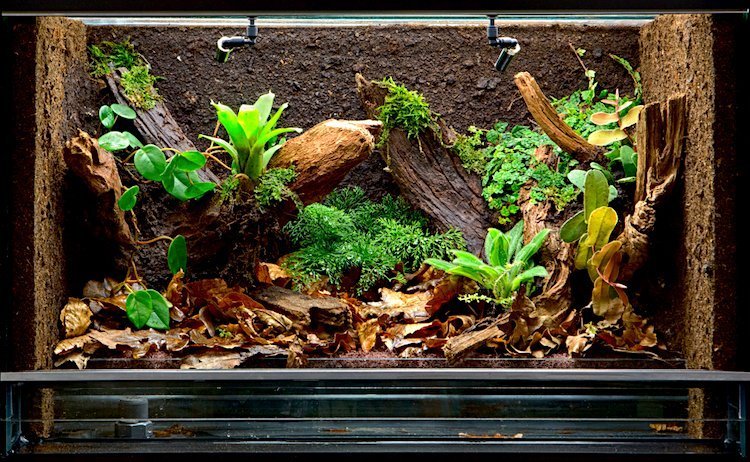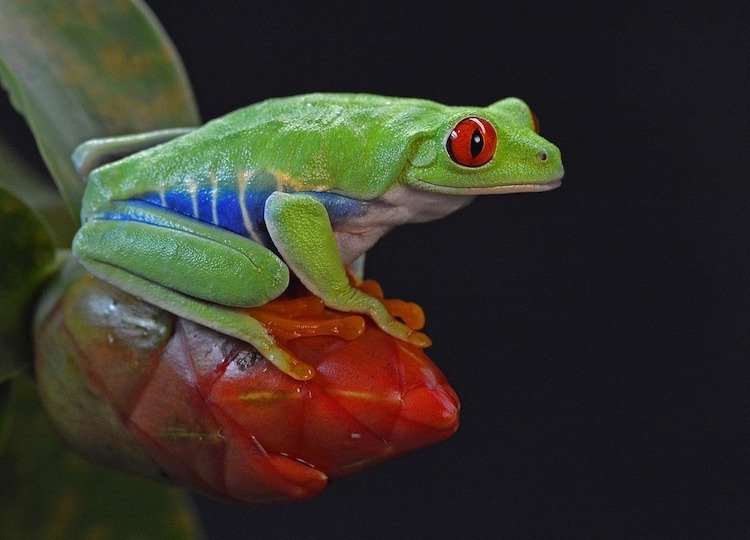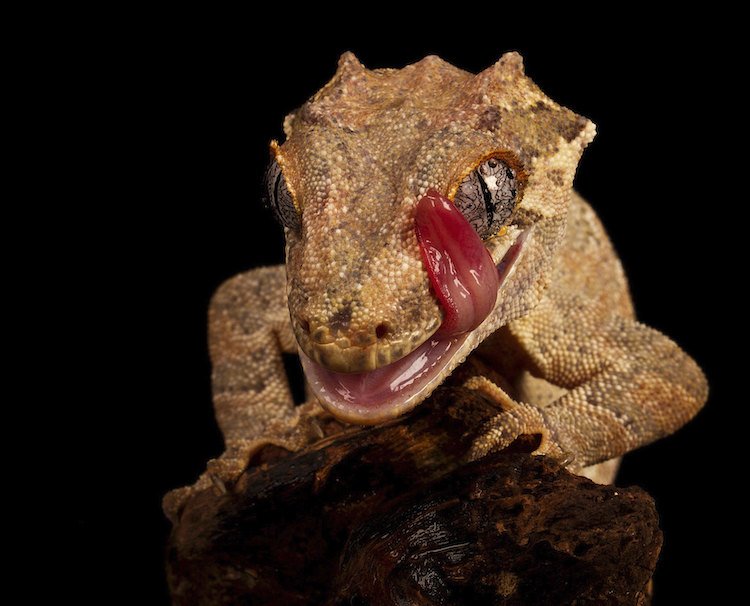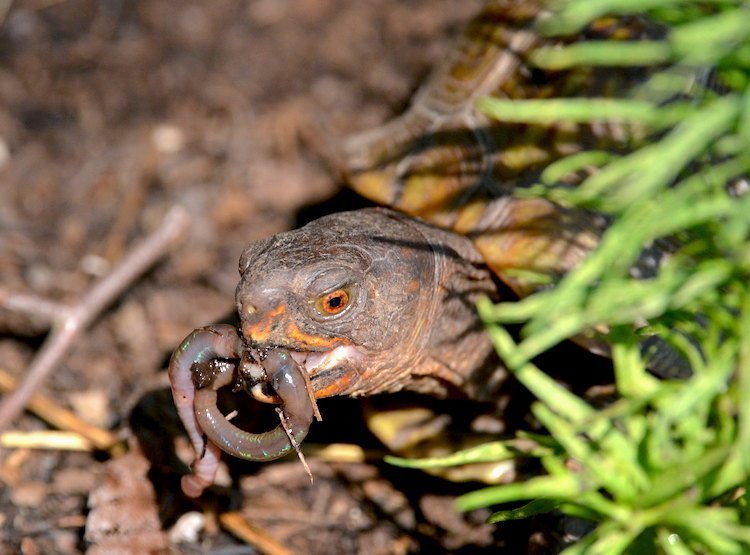
With self-cleaning bioactive terrarium setups becoming more popular with people caring for pet reptiles and amphibians, so too are the “hidden janitors” within these enclosures — the so-called cleanup crew of small bugs and worms that break down the pets’ waste products.
A bioactive terrarium usually involves several elements that work together in balance to create a naturalistic, aesthetically pleasing home for reptiles and amphibians.
- Live plants clean the air, retain humidity and provide cover for any inhabitants.
- The substrate allows the plants to root and grow.
- And the microfauna cleanup crew (those little bugs and worms) eat mold, decaying food, and waste and then break it all down into a form more easily processed by the plants and fungi in the terrarium.
As Zach Brinks from Reptiles magazine says, “The bioactive movement promises a better standard of care with a fraction of the time required to keep our critters clean.”
But Brinks also cautions that “with great power comes great responsibility.”
“Setting up a bioactive enclosure is not as straightforward as your more typical habitat,” he says.
In this article, I’ll share some beginner tips on setting up your bioactive terrarium — plus some detailed advice on choosing the appropriate cleanup crew for your new setup.
Bioactive Terrarium: Substrates
Many tropical or subtropical enclosures often call for higher humidity, which involves using moisture-holding substrates like Eco Earth or potting soil.
For geckos, Brinks swears by Josh’s Frogs BioBedding Tropical. Plants grow well in it, and it “drains well while slowly wicking moisture to the surface,” he says.
To help create a more natural, self-maintaining ecosystem — a bioactive terrarium — you’ll add certain insect species into the substrate. These insects will eventually establish a breeding population within the enclosure.
I started my own isopod culture with 25 individuals, and it took a few months before they started breeding.
Be sure to add extra food for them to encourage growth. Bury soft vegetables or peelings about 1–2 inches in the substrate once a week or so. As your cleanup crew starts to breed and grow in number, you can stop providing the extra food.
The substrate may also have fungi beneath the surface that help break down waste and other materials — a process that turns the waste into nutrients for live plants in the enclosure.
Occasionally, especially in the first few weeks of your bioactive terrarium setup, you may have a few mushrooms pop up. These are just the fruiting bodies of the network of fungi under the soil. This fungi network is made up of thin, white hairlike structures called mycelium, which has been shown to form a beneficial relationship with plants.
This is why it’s a good idea to add “beneficial fungi,” according to Brinks, a lifelong herper with a degree in zoology/animal biology.
“Many fungi grow in conjunction with plants, helping them get adequate nutrition and fueling growth. By introducing these specific types of fungi to the enclosure, you can create a mature, healthy bioactive cycle more quickly,” he says.
“Some products, such as Josh’s Frogs Bioactive Booster, provide beneficial fungal spores and trace elements that can be added directly to the soil.”

Which Reptiles and Amphibians Will Benefit From a Bioactive Terrarium?
Because bioactive terrarium setups tend to be more on the tropical side, most desert species won’t be suited for them. You will need to stick with animal species that come from more tropical and temperate habitats.
Remember to research your chosen reptile or amphibian species well before bringing them home.
Frogs:
Frogs are a wonderful choice for a bioactive terrarium because they will feel right at home in a humid, planted enclosure. Many frogs are colorful and readily available.
There are a few frogs on the list above that are voracious eaters, so you’ll need to be careful about not overfeeding them.

Salamanders:
Salamanders are fascinating animals, and the ones I’ve listed above are colorful. They are well-known in the hobby and can reach lengths of up to 1 foot. They like sticking close to the ground and underneath dark hiding spots.
They are generally good eaters and can become accustomed to begging.

Geckos:
Geckos, especially arboreal (tree-dwelling) ones, are fun to watch and come in a wide variety of color morphs.
I’ve had the privilege of seeing all species on this list in person, but my favorites have to be the Day Geckos. They are stunning green and red and full of personality. However, they aren’t the kind to be handled since they are quite delicate.
Crested and Gargoyle Geckos are your best bet if you want one that can tolerate handling.

Turtles:
There are a few box turtles that do very well in a bioactive terrarium. These reptiles need the higher humidity and enjoy lush plants to hide under. They actively hunt for bugs and worms and love to bury themselves in mulch, moss and dirt when they have a chance.
I can speak from experience with my Eastern Box Turtle that he loves the live plants for hiding spots. While he could munch on the pants, he usually doesn’t have any interest.
If you use live plants in your enclosure, be sure they are turtle-safe.
What the Cleanup Crew Does
The insects and fungi in your bioactive terrarium will consume decaying bits of food, mold and waste, which will help maintain a healthier substrate. They also aerate the soil as they burrow through it.
They may also serve as occasional snacks for frogs or small reptiles in the enclosure.
The biggest benefits, though, are that the substrate is kept free of mold outbreaks and more harmful types of bacteria aren’t allowed to flourish. This is an invaluable perk for amphibians and reptiles that may be sensitive to fungal or bacterial infections.
Once the ecosystem is in balance and your bugs are breeding well, you don’t have to do much other than spot cleaning every once in a while. Decaying wood and leaves are a natural part of their diet, so you can just leave any fallen leaves from plants where they fall.

Isopods
Isopods, otherwise known as pillbugs, sowbugs, woodlice or rolly pollies, are amazing little janitors.
There are various species on the market with different colors and sizes available. They are widely used in many bioactive terrariums these days as cleanup crews for anything from Poison Dart Frogs to Box Turtles.
Isopods aren’t actually true bugs, but rather a terrestrial crustacean. They have primitive gills that allow them to breathe in high-humidity environments. This is why the substrate they live in must be kept moist, or they’ll die.
Isopods love to hang out under water dishes, bark and leaf litter. Offer them these hiding spots and they should do very well for you.
Leaf litter may also help retain moisture in the substrate. Over time, you may need to replace leaf litter or wood as they eventually break it down.
The isopods on land actually have a cousin in the ocean known as the Deep Sea Giant Isopod. These gigantic versions play an important role in the decomposition of whale carcasses — yes, dead whales — that fall to the ocean floor. They are a member of the cleanup crew on the seabed, mirroring their land relatives.
Springtails
Named for their jumping behavior, springtails are white arthropods measuring no more than 1/4 inch in size.
They consume mold and decaying matter in their environment. They also have the ability to walk across the surface of the water. They can be used as food for smaller amphibians.
Buy starter cultures if you want to add them to your enclosure, or start a larger culture for multiple tanks and as a food source.
Fungi
Fungi play a crucial role in maintaining the health of forest ecosystems, and it is no different on a smaller scale with your bioactive terrarium.
We are used to seeing mushrooms out in the wild, but occasionally they will sprout up in the home terrarium. I’ve had this happen a few times in my own, and it’s a good sign of a healthy habitat.
As mentioned, mushrooms are only the fruiting bodies of the network of white, hairlike mycelium and help break down organic waste and transform them into nutrients within the soil. This, in turn, is beneficial to live plants in the enclosure, as it is natural fertilizer.
Fungi may even benefit your plants in an even more intimate symbiotic relationship: The mycelium of some species of fungi will make connections to plants through their root systems to gain nutrients, and then share essential nutrients the plants may never get anywhere else. This connection will go a long way to improving both the health of the soil and plants.
There are specialty substrates available that are seeded with these beneficial fungi that are made specifically for bioactive setups.
To help maintain the fungi within the enclosure, you’ll need to add wood, leaf litter and other organic materials to the substrate as they are broken down.
- If you have an area near you that is free of pesticides, you can collect wood and then bake it in the oven at 250–300 degrees Fahrenheit for 30–60 minutes to kill any parasites. Always supervise the oven if you plan to bake wood.
- Or you can find online vendors that sell wood, leaf litter and moss that is safe for your enclosure.
Where to Find Your Cleanup Crew
While you can go out into the woods or around your neighborhood to find some of these bugs, you should be sure they are in an area free of pesticides.
Even then, you should consider keeping them in a separate tank from your pet for at least 1–2 months, and wait until they breed the first generation for you.
Many reptile hobby shops and online vendors now sell these beneficial bugs at reasonable prices. Insects bought through these sources are generally born and bred in pesticide-free conditions, which should give you peace of mind.
With a starter culture, you will be able to have your own colony of breeding individuals in time. As stated before, you may need to give extra food to get them started.
This video explains more about setting up a bioactive terrarium:
Final Thoughts on Bioactive Terrariums
Joining the world of bioactive terrariums is becoming more and more popular, and it is in no way an unreachable goal. Now more than ever, supplies and livestock for these naturalistic setups are available to just about anyone with a terrarium, no matter the size.
The funny thing I’ve noticed is that sometimes the bugs themselves are enjoyable to watch within the enclosure. They busily scurry to the surface when I mist the substrate and gather around bits of dropped food eating leisurely.
I definitely recommend these janitor insects if you ever decide to jump into the naturalistic enclosure.



